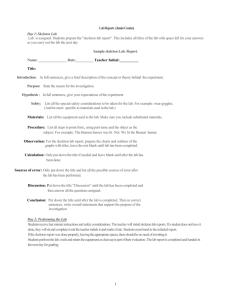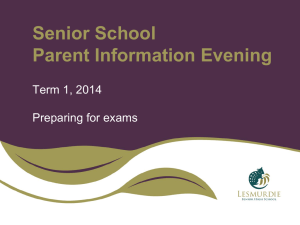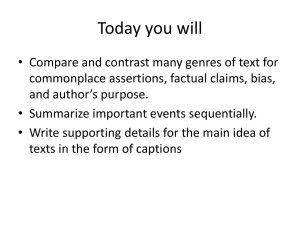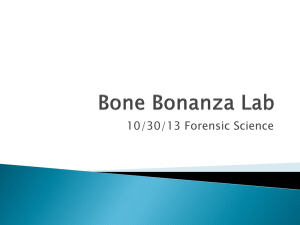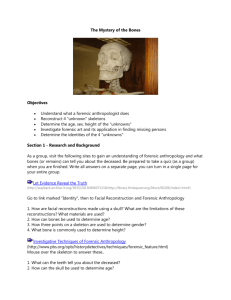CRIM LAB HOURS – Written in Bone
advertisement
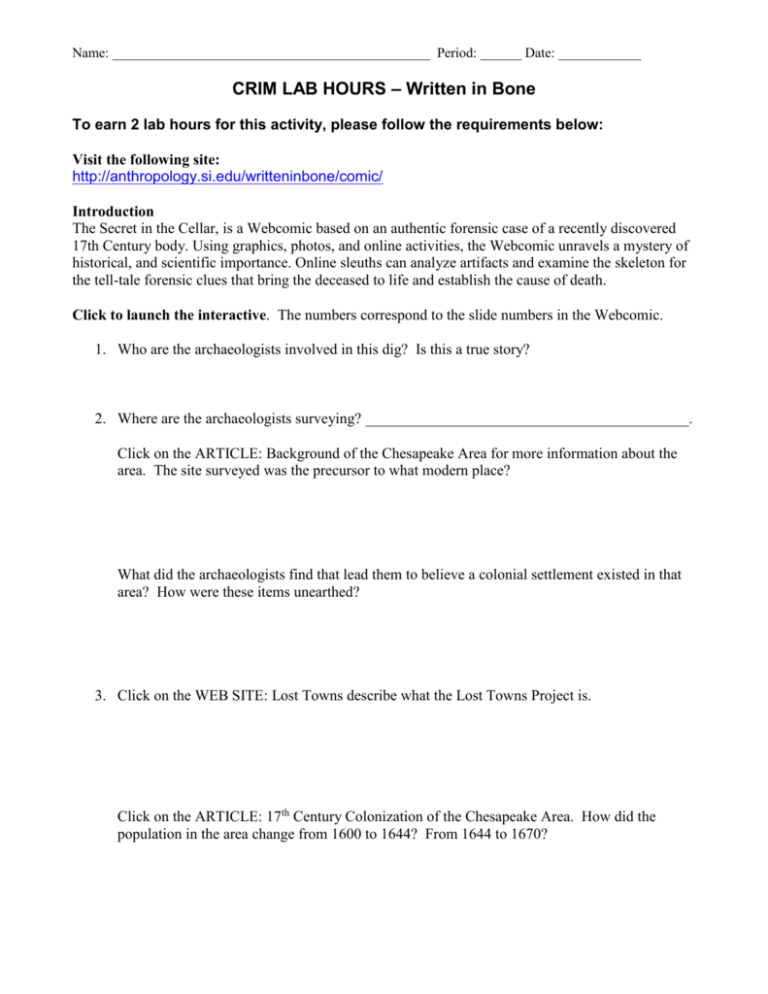
Name: ______________________________________________ Period: ______ Date: ____________ CRIM LAB HOURS – Written in Bone To earn 2 lab hours for this activity, please follow the requirements below: Visit the following site: http://anthropology.si.edu/writteninbone/comic/ Introduction The Secret in the Cellar, is a Webcomic based on an authentic forensic case of a recently discovered 17th Century body. Using graphics, photos, and online activities, the Webcomic unravels a mystery of historical, and scientific importance. Online sleuths can analyze artifacts and examine the skeleton for the tell-tale forensic clues that bring the deceased to life and establish the cause of death. Click to launch the interactive. The numbers correspond to the slide numbers in the Webcomic. 1. Who are the archaeologists involved in this dig? Is this a true story? 2. Where are the archaeologists surveying? ___________________________________________. Click on the ARTICLE: Background of the Chesapeake Area for more information about the area. The site surveyed was the precursor to what modern place? What did the archaeologists find that lead them to believe a colonial settlement existed in that area? How were these items unearthed? 3. Click on the WEB SITE: Lost Towns describe what the Lost Towns Project is. Click on the ARTICLE: 17th Century Colonization of the Chesapeake Area. How did the population in the area change from 1600 to 1644? From 1644 to 1670? 4. Define the terms shovel test pit and geophysical surveys (use links). 5. Click on the ARTICLE: What is Archaeology? Describe the general role of an archaeologist and the 3 main types of archaeology. What types of information can the 3 types of archaeology provide? 6. Why does Janet warn Ana that they will most likely only find “an old jug or two”? 7. What did Ana find working in a shallow trench in her quadrant of the old cellar? 8. Does Janet believe Ana’s finding? 9. What was unusual about Ana’s finding? What questions arose from this finding? 10. What does Charles want to know about the finding? 11. Summarize Ana’s journal entry. Why is it important for archaeologists (and scientists in general) to record their findings, either through journals, data tables, etc.? 12. Why does Dr. Howell get involved in the mystery? Click on the ARTICLE: Battle of the Severn. Summarize who was involved in this battle, where it took place (especially in context to the archaeological dig site), and when it occurred. 13. A theory begins to emerge....what is it? 14. Click on the ACTIVITY: Can You Date This Site to explore how each type of evidence (building elements, coins, pipes-both belly and trade, and record research) were used to determine the age of the site. Be specific! 15. What is terminus post quem? How did the coins establish the terminus post quem in this site? What impact did that have on the researchers’ theory of to whom the skeleton belonged? 16. Click on ACTIVITY: Is the Skeleton Male or Female? Describe how you can use the pelvic bones and skull to determine gender. At the bottom, determine whether the skeleton in the cellar is male or female (check your answer) and record. Click on ACTIVITY: Can You Identify the Age? Describe how you can use teeth and bones to determine age. Click on ACTIVITY: Can You Identify Ancestry? Describe how you can use skull to determine the ancestry. At the bottom, determine whether the skeleton in the cellar is European, American Indian, or Sub-Saharan African. 17. Dr. Kingsley studies the skeleton in situ. What conclusions does he make? What else has to be examined at the lab? 18. Click on ACTIVITY: Is There Evidence of Trauma? Describe how you can tell if an injury is antemortem, perimortem, or postmortem. How many bones showed evidence of fracture in the cellar? Describe the bone(s) impacted and the type of injury (injuries) exhibited. 19. What does Ana write in her journal now? 20. Dr. Kingsley uses two pieces of information to determine the skeleton’s age. What are they? 21. What does Dr. Kingsley say about the injuries to the skeleton? 22. Click on ACTIVITY: Can You Determine Diet? Describe the differences between a C4 and C3 diet in terms of radioactive dating. Looking at the data for the skeleton in the cellar, what type of diet did they most likely have? Does this suggest the skeleton was an American-born colonist or English-born colonist? 23. What notes does Ana add to her journal? 24. Click on ACTIVITY: Can You Identify Activity Patterns? Describe what a cortical bone excavation is and when you would see it. Describe what Schmorl’s nodes are and when you would see it. Did the skeleton in the cellar have any evidence of either? What conclusion can be made from this? Click on ACTIVITY: Can You Identify Disease in Bone? Describe the disease(s) that would result in characteristic bone destruction and/or abnormal bone formation. Describe any disease(s) that could be determined from the skeleton in the cellar and provide examples from the activity to support your claims. 25. Click on ACTIVITY: Conditions in the Early Colonies. If the skeleton does not belong to a enslaved African, what possible “social status” individual could it have belonged to? Describe the conditions these individuals faced in the 17th century. 26. Click on ACTIVITY: What Caused this Boy’s Death? Describe what the cause of death was and why he was buried the way he was. 36. Click on ARTICLE: Forensic Facial Reconstruction. Describe the process of forensic sculpting. Did the reconstructed face look like what you had pictured or envisioned? Summarize what you have learned through this Webcomic. What did you learn about forensic anthropology from this Webcomic? Are you surprised at the number of tests there are or pieces of information that can be determined simply from looking at bones?
